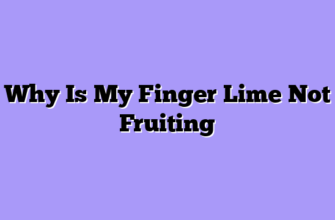When I first heard about finger limes fifteen years ago, I thought someone was pulling my leg. “Caviar that grows on trees?” I scoffed. But here I am today, running one of the most successful finger lime operations in the region, and let me tell you – these little green gems have completely transformed my farming business and my understanding of what exotic fruit cultivation can achieve.
You know how some discoveries just hit you like lightning? That’s exactly what happened when I first cracked open a finger lime and watched those tiny, pearl-like vesicles burst on my tongue. The intensity was incredible – like a lime had been concentrated into tiny flavor bombs. I knew immediately that I had to figure out how to grow these remarkable fruits.
The Early Days: Learning the Ropes
Starting my finger lime journey wasn’t exactly smooth sailing. These Australian natives are finicky creatures, nothing like the straightforward citrus I’d been growing for decades. The first challenge? Getting my hands on quality propagation material. Back then, finger limes were still relatively unknown in commercial agriculture, and finding reliable sources felt like searching for treasure.

The grafting process became my obsession. Unlike traditional citrus grafting, finger limes require specific rootstock compatibility. Through countless trials and more failures than I care to admit, I discovered that trifoliate orange rootstock worked best in my climate zone. The technique itself is like performing surgery on a plant – you need steady hands, sharp tools, and infinite patience.
Here’s what I learned about successful finger lime propagation:
- Timing is everything – Late winter to early spring provides the best success rates
- Clean cuts matter – Any contamination can kill your graft union
- Humidity control – Too dry and the graft fails, too wet and you get rot
- Temperature stability – Fluctuations stress the developing union
- Patience pays off – Don’t expect results for at least 8-12 weeks
Mastering the Art of Propagation
After five years of experimenting, I developed my signature propagation method. It’s a modified whip-and-tongue graft that I’ve refined specifically for finger limes. The process requires precision that would make a watchmaker proud, but the results speak for themselves.
My propagation schedule follows this strict timeline:
- January-February: Prepare rootstock seedlings and select scion wood
- March: Perform grafting operations during mild weather
- April-May: Monitor graft unions and maintain optimal greenhouse conditions
- June-August: Begin hardening off successful grafts
- September: Transplant to larger containers or field positions
- October-December: Establish plants and prepare for winter protection
The magic happens in my custom-built propagation greenhouse. I’ve invested in climate control systems that maintain exactly 75-80°F with 85% humidity during the critical healing period. Sound excessive? Maybe. But when you’re dealing with grafts that cost $50 each in materials and labor, you don’t take chances.
One thing that surprised me was how different finger lime varieties respond to propagation. Red champagne finger limes graft like they’re eager to please, while the green varieties can be absolute divas. The pink ice variety? Don’t even get me started – it’s like trying to negotiate with a teenager.
| Finger Lime Variety | Grafting Success Rate | Days to Union | Commercial Viability |
|---|---|---|---|
| Red Champagne | 85% | 45-60 | Excellent |
| Green | 70% | 60-75 | Good |
| Pink Ice | 60% | 75-90 | Fair |
| Yellow | 75% | 50-65 | Very Good |
| Purple | 80% | 55-70 | Excellent |
From Grove to Gourmet: The Culinary Revolution
Three years after my first successful grafts produced fruit, I realized I’d stumbled into something bigger than just farming. These finger limes weren’t just another crop – they were culinary gold. The tiny vesicles, each containing a burst of acidic perfection, transformed every dish they touched.
My first restaurant client was a local chef who’d heard rumors about my “lime caviar.” When I brought him a small container of freshly harvested vesicles, his eyes lit up like a kid on Christmas morning. He immediately started experimenting – adding them to seafood dishes, cocktails, even desserts. Within weeks, I had a waiting list of chefs desperate for my finger limes.

What amazes me most is the versatility. I’ve watched chefs use my finger limes in ways I never imagined. One creative soul uses them in molecular gastronomy, creating “exploding” lime caviar that bursts with even more intensity. Another chef incorporates them into artisanal chocolates, creating a sweet-tart experience that’s absolutely mind-blowing.
The economics are pretty compelling too. While regular limes might sell for $2-3 per pound wholesale, my finger limes command $40-60 per pound directly to restaurants. The math is simple – even with the longer growing time and more intensive care required, the profit margins make traditional citrus look like pocket change.
But here’s what really drives me: the satisfaction of mastering something truly challenging. Every successful graft, every perfect harvest, every delighted chef represents years of dedication, failure, learning, and persistence. When I see diners experiencing that first pop of finger lime vesicles, their faces lighting up with surprise and delight, I know all those early struggles were worth it.
Today, my finger lime operation spans twelve acres with over 2,000 producing trees across fifteen varieties. I supply restaurants in four states and have a six-month waiting list for new plants. Not bad for something that started as curiosity about “caviar that grows on trees.”
The journey taught me that exotic fruit farming isn’t just about growing something different – it’s about understanding that some of the most rewarding challenges come disguised as impossible dreams. Sometimes the craziest ideas turn out to be the most brilliant investments you’ll ever make.









I have little information on propagation techniques. Do you use hormone for rooting and what strength? Does it take several years to fruit from a cutting? Does bottom heat help and suggested temperature? Do the lime respond to changes in day length with regard to flowering, growth rate, ripening? What is the optimal pH?
Hi, Harry!
Thank you for your detailed questions! I’m happy to share what works well for finger lime propagation:
Rooting Hormone & Technique:
Yes, rooting hormone significantly improves success rates. I recommend using IBA (indole-3-butyric acid) at 3,000-8,000 ppm for semi-hardwood cuttings. Dip the cut end for 5-10 seconds. Take 4-6 inch cuttings from healthy, disease-free wood that’s partially matured—not too soft or too woody.
Time to Fruit:
Cuttings typically take 2-3 years to produce their first fruit, sometimes up to 4 years depending on growing conditions and variety. This is actually faster than seed-grown plants, which can take 5-7 years. Grafted plants fruit even sooner, usually within 1-2 years.
Bottom Heat:
Bottom heat definitely helps! Maintain the rooting medium at 70-75°F (21-24°C). This promotes faster root development and reduces rot. Air temperature can be slightly cooler, around 65-70°F. High humidity (70-80%) is also crucial—use a propagation dome or misting system.
Photoperiod Response:
Finger limes are subtropical and do respond to day length, though not as dramatically as some citrus. Flowering is primarily triggered by temperature changes and moisture stress rather than photoperiod. They tend to flush and flower multiple times per year in optimal conditions. Growth slows in shorter winter days, and fruit ripening takes 4-5 months from flower set.
Optimal pH:
Finger limes prefer slightly acidic soil with a pH of 5.5-6.5, similar to other citrus. They’re quite sensitive to alkaline conditions, which can cause nutrient deficiencies (especially iron and manganese). Well-draining soil is essential—they won’t tolerate waterlogged roots.
Hope this helps with your propagation efforts! Feel free to ask if you have more questions.